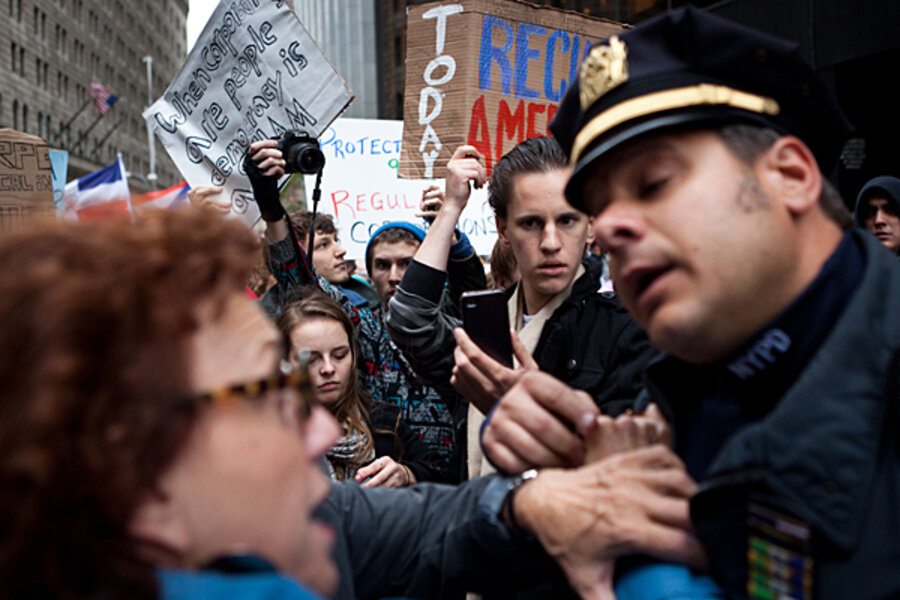Occupy Wall Street plans biggest marches yet, but can it avoid pitfalls?
Loading...
| Los Angeles
More and more, “Occupy Wall Street” is on the move.
Following a week that saw a “millionaires' march” by the homes of the wealthy and powerful in New York and rallies outside banks in downtown Los Angeles, the protest movement is preparing for its biggest action yet: marches this Saturday by all 1,300-and-counting Occupy chapters worldwide.
But as this transition from words to action escalates, so do brushes with local authorities. Scores of Boston protesters were arrested for camping on the wrong lawns, while 12 activists were arrested and charged with trespassing for refusing to leave the lobby of a downtown Los Angeles branch of Bank of America.
Those increased confrontations with the law could be politically perilous for the movement, which, say observers and the protesters themselves, is at a critical stage in defining its purpose and its goals.
A Reuters-Ipsos poll released Wednesday shows that while 82 percent of Americans are aware of the Occupy movement, 38 percent feel favorably toward it and 24 percent view it unfavorably.
Occupy’s message is getting through to the public for now, but an escalation of violent encounters could easily overwhelm that, says Richard Levick, CEO of Levick Strategic Communications, a firm that specializes in crisis management.
“The Occupy Wall Street movement must not allow clashes with police or fringe elements [within the movement] to define who it is, or it will cease to exist,” he says.
In Los Angeles, police are exercising restraint, for now.
From where he sits in his office, Los Angeles Police Commander Andrew Smith says he has a clear view of the 258-tent encampment stretching out in front of City Hall.
At first, he notes, when there were just a few tents, the police insisted they move from the grass to the sidewalk at night. But “now that there are so many it’s not practical because it would completely block the sidewalk,” he says. “So we just let them stay on the lawn.”
As long as the groups are peaceful, “it’s a low-grade infraction,” he says. “As long as things don’t escalate into property damage or harm to people, we won’t enforce small infractions.”
But violence may not be the only shoal in the waters ahead for the Occupy movement. The cost of protesters' presence in the downtown areas of large cities is starting to mount, both in terms of finances and reallocated resources, and could test city officials’ patience.
Boston police announced this week that they anticipate a $2 million tab for police overtime in dealing with the protesters.
While Los Angeles does not pay for overtime, notes Commander Smith, “every officer deployed to deal with the protesters is someone that isn’t patrolling the streets or available for emergency responses.”
Members of the Los Angeles encampment acknowledge that they cannot stay on the streets forever. They say they are working hard to take the group to the next stage. Film producer Jil Hardin says the next big order of business to avert the fate of many short-lived protests “is to find a building where we can begin to organize and be more effective.”
Ms. Hardin was quick to note that she is not a spokeswoman for the group, rather one of many who congregate for the nightly steering committee meetings in front of City Hall. She says they are hunting for a site somewhere in the downtown area, “so we can stop worrying only about the day-to-day issues like feeding people and taking out trash.”
Groups in other cities are considering this same idea, she says.
As someone accustomed to using local streets as film locations, Hardin says she knows the importance of cooperating with local officials to get things done. Her local Occupy group is planning a Saturday march from downtown Pershing Square to City Hall.
“We have permits and a very good relationship with the Los Angeles Police Department,” she says. “This is something we have worked on from the very beginning.”
Moving off the streets would serve another purpose of which the LAPD itself is keenly aware. “Inside this group there are nihilists and anarchists that have embedded themselves. They advocate things that we don’t want any part of here,” says Smith.
The clock is ticking for the movement’s efforts to forestall negative incidents, says Chris Falkenberg, former US Secret Service agent and president of Insite Security, a firm that provides security for high net-worth individuals.
He says the movement can take a lesson from the constant vigilance that lies at the heart of his work.
“Movements like this tend to attract all kinds of people,” he says. “Most of the people in these parks have very good motives and ideals, but they need to be aware that not everyone joining in has the same pure motives they do.”





